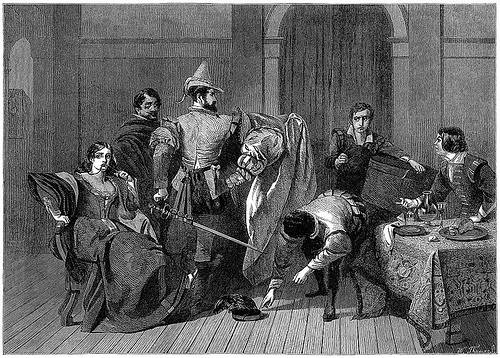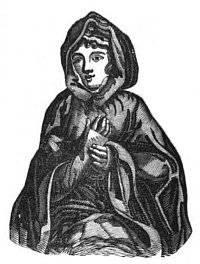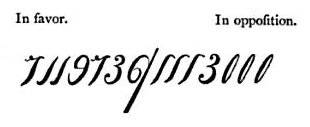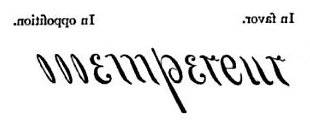lexiphanic
adj. using pretentious words
Author: Greg Ross
Vitrified Forts
Throughout Europe geologists have found ancient hill forts whose walls have apparently been fused by fire. An intense heat has partly melted some stones and left others encased in a glassy coating. In some cases an entire wall has been merged into a solid mass.
No one knows who did this, how, or why.
Mirror, Mirror
The following curious effect of the combination of figures has been sent to us by a friend in Paris, who states that it has been extensively circulated in that capital. We have not yet seen it in print here.
The votes upon the Presidency of Louis Napoleon were,–
Place the above in front of a mirror, so that the reflection of it may be visible:
This reflection will read, ‘III Empereur‘–Third Emperor. Louis Napoleon affects hereditary superstition, and it is stated that this singular coincidence confirmed him in the belief which he has always entertained of the exalted destiny for which Providence reserved him.
— Harper’s Magazine, 1857, quoted in Appleton Morgan, Macaronic Poetry, 1872
Unimpressed

Samuel Pepys’ opinions of Shakespeare’s plays, from his diary:
- A Midsummer Night’s Dream: “I had never seen [it] before, nor shall ever again, for it is the most insipid, ridiculous play that ever I saw in my life.”
- The Taming of the Shrew: “It hath some very good pieces in it, but generally is but a mean play.”
- Romeo and Juliet: “It is a play of itself the worst that ever I heard.”
- The Merry Wives of Windsor: “The humours of the country gentleman and the French doctor very well done, but the rest but very poorly, and Sir J. Falstaffe as bad as any.”
- Henry IV, Part 1: “It did not please me.”
- The Two Noble Kinsmen: “No excellent piece.”
- Twelfth Night: “One of the weakest plays that ever I saw on the stage.”
“August 20th, 1666. To Deptford by water, reading Othello, Moor of Venice, which I ever heretofore esteemed a mighty good play; but … it seems a mean thing.”
Beginner’s Luck
Giants pitcher Hoyt Wilhelm hit a home run on his first at-bat in the major leagues.
He played for 21 seasons but never hit another homer.
“Human Bones in Solid Rock”
With others of our fellow-citizens, I have been highly interested in the discovery of human bones in a solid sandstone rock, of a quarry near Cusick’s mill, about six miles from the city, and with the assistance of Mr. Charles Bobbins and Dr. Ball have taken steps thoroughly to investigate this highly interesting subject. … The bones submitted to my inspection are the bones of an adult female, they were contained in a cavity of the solid sandstone rock, perfectly close, having no communication whatever with any fissure or crack of the rock. The cavity represents the shape of the body, invested with flesh; the leg, thigh, hip and part of the back are moulded with beautiful exactness, and would, if filled with plaster of Paris, give a mould, preserving all the graceful curves of the entire body.
— John G.F. Holston, Zanesville [Ohio] Courier, quoted in Mining Magazine, November 1853
A Double Rainbow
You can multiply these two numbers by simply jumbling their digits:

Remarkably, the same thing happens when you square their product:

Person to Person
If you’re an extrovert, you’ll be happiest (in principle) in northeastern Pakistan. That’s the world center of population — from there, the average distance to every human on earth is only 3,200 miles.
Conversely, if you’re an introvert you should visit Easter Island, where you’ll be 9,300 miles from the average fellow man.
See also Point Nemo and Vroom!
Night Drop
Abraham Newland slept in the Bank of England every night for 25 years.
He retired as chief cashier in 1807.
Buried Alive

On Feb. 2, 1799, 42-year-old Elizabeth Woodcock was returning from market to her home in Cambridge when she was overcome with fatigue and lay down in a field. A heavy storm had overtaken her, and she came to her senses under six feet of snow, in which she remained buried for eight days.
Her cries went unheard, but she managed to tie a handkerchief to a stick and thrust it through the snow, where a passing farmer finally noticed it and went for help. When shepherd John Stittle pulled her free, she said, “I have been here a long time.” “Yes,” he said, “since Saturday.” “Ay, Saturday week,” she replied. “I have heard the bells go two Sundays for church.” She’d been lying only half a mile from her home.
Woodcock lost her toes to frostbite and lingered until the following July, when she died. “We are sorry to add,” notes the Gentleman’s Magazine, “that too free indulgence in spirituous liquor is supposed to have been the cause both of the accident which befel Elizabeth Woodcock, and its fatal consequences.”


